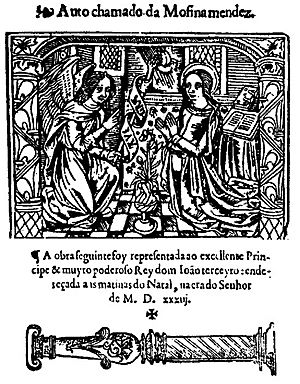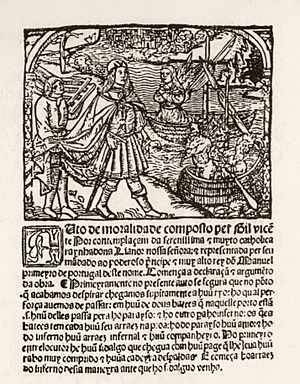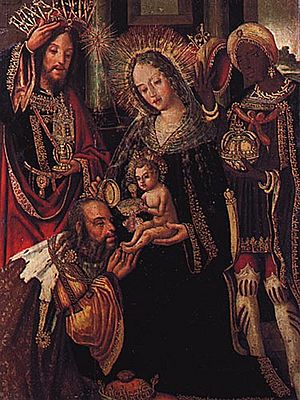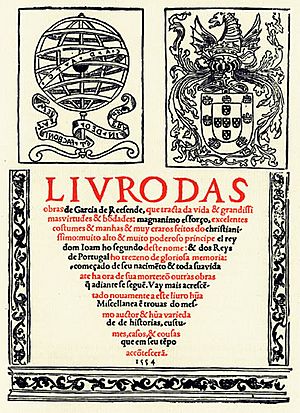Gil Vicente facts for kids
Quick facts for kids
Gil Vicente
|
|
|---|---|

Statue atop the pediment of
D. Maria II National Theatre |
|
| Born | c. 1465 possibly Guimarães, Portugal |
| Died | 1536 (aged 70–71) possibly Évora, Portugal |
| Occupation | Playwright, goldsmith (disputed) |
| Nationality | Portuguese |
| Alma mater | University of Salamanca (assumed) |
| Subject | Religion, satires |
| Literary movement | Renaissance humanism Portuguese Renaissance |
| Notable works | A Trilogia das Barcas, Farsa de Inês Pereira, Monólogo do Vaqueiro |
Gil Vicente (c. 1465 – c. 1536) was a famous Portuguese playwright and poet. He was also an actor and director of his own plays. Many people call him the "Father of Portuguese drama." He is seen as one of the greatest playwrights in Western literature.
Vicente wrote poems too. He wrote in both Portuguese and Spanish. Because of this, he is also considered a founder of Spanish drama, along with Juan del Encina.
He worked for the Portuguese kings Manuel I and John III. Queen Leonor of Viseu helped him become well-known. She saw him in court plays and asked him to write his first play.
Some people believe he was also a skilled goldsmith. This goldsmith worked for the royal court in Évora. He created the famous Belém Monstrance.
Vicente's plays and poems show the changes happening in his time. This was when Europe moved from the Middle Ages to the Renaissance. His works balanced old traditions with new ideas.
Many of his plays celebrated religious holidays or royal events. Others used popular culture to entertain people. They often made fun of Portuguese society.
Later, some of his works were stopped by the Portuguese Inquisition. This made his fame fade for a while. But today, he is known as a key figure of the Portuguese Renaissance.
Contents
Gil Vicente's Early Life

Most people agree that Gil Vicente was born around 1465. However, the exact year is not certain. Some of his own writings suggest different dates. Since 1965, the year 1465 has been widely accepted.
His birthplace is also a mystery. Some think he was born in Barcelos. Others suggest Guimarães, which fits the idea of him being a jeweler. The people of Guimarães like this theory. There is even a school named after him there. Some stories say his father was from Guimarães. Other ideas place his birth in Lisbon or the Beira region.
Gil Vicente married Branca Bezerra first. They had two sons, Gaspar and Belchior. After she passed away, he married Melícia Rodrigues. With Melícia, he had several children. These included Paula Vicente, who became a famous scholar. His son Luís Vicente later collected and organized his father's works.
In 1531, Gil Vicente was in Santarém during a big earthquake. Rumors spread that the earthquake was a punishment from God. Some people blamed the Jewish community. Gil Vicente spoke out against these rumors. He wrote a strong letter to King John III. He scolded the friars for causing fear. This action may have stopped violence against Jewish people and new Christians.
Gil Vicente died in an unknown place, possibly Évora. He stopped writing around 1536, which is thought to be the year he died. We don't know where he was buried. Also, there are no known pictures of him that survived.
His Career as a Writer
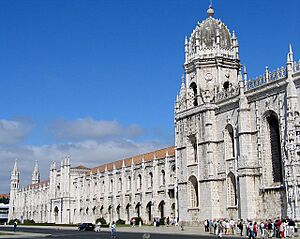
It is believed that Gil Vicente studied in Salamanca. He first studied law but soon changed to literature.
In 1493, he became a master of rhetoric for the Duke of Beja. This duke later became King Manuel. This job allowed Vicente to work at the royal court. His first known play was O Monólogo do vaqueiro ("Monologue of the Cowherd"). He wrote it in Spanish. It was performed for Maria of Aragon (1482–1517), King Manuel's wife. The play celebrated the birth of Prince John, who would become John III of Portugal. Gil Vicente himself performed the play on June 8, 1502. The king, queen, and other royals were there.
O Monólogo do vaqueiro was inspired by the story of the Adoration of the Shepherds. It included simple gifts, like cheese, for the new prince. People expected great things from the future king.
Queen Leonor asked him to perform the play again for Christmas. But Vicente decided to write a new play instead. This was the Auto Pastoril Castelhano ("Castilian Pastoral Act"). The court loved it. They asked for another play for Twelfth Night. So, he wrote the Auto of the Wise Kings. Queen Leonor became his biggest supporter. She helped him realize his talent could do much more.
Vicente was in charge of organizing palace events. He also directed celebrations for Eleanor of Spain in 1520. In 1521, he started working for John III of Portugal. He became important enough to make fun of the clergy and nobility in his plays without trouble. His popularity even allowed him to disagree with the king. For example, he wrote a letter in 1531 defending the New Christians.
For 30 years, he entertained the royal courts. He traveled with them and provided plays for both sad and happy times. Gil Vicente was an actor and writer. He did not have a regular acting group. But he likely found students and court servants to perform his plays. Plays usually ran for only one night.
As a Goldsmith
Many experts believe that Gil Vicente the writer was also a goldsmith. The playwright used many technical terms from goldsmithing in his works. This makes the idea believable.
In 1881, Camilo Castelo Branco wrote that they were two different people. Later, Teófilo Braga also changed his mind. But other studies showed that the records used to separate them were not accurate.
The goldsmith's most famous work was the monstrance for the Jerónimos Monastery in Belém. He made it in 1506 from the first gold brought from Mozambique. This monstrance's design looks like the decorations on the monastery's church.
Three years later, he oversaw the valuable items of several religious places. In 1511, he became a special servant to the King. A year later, he represented jewelers in a royal council. In 1513, as master of the mint, he was chosen to represent other masters in Lisbon.
Gil Vicente's Written Works
Gil Vicente wrote plays from 1500 to 1536. Most of his plays were for the royal court. He and the court members often performed in them. He wrote at least 44 plays. Ten were in Spanish, 14 in Portuguese, and the rest mixed both languages. His plays fall into four main types: devotional plays (called "acts"), comedies, tragicomedies, and farces.
Like Spanish classical dramas, his plays were often written in verse form. They also included his own music. He used popular songs and tunes of the time.
He was also a well-known lyric poet in both languages. Many of his poems are in the Cancioneiro of Garcia de Resende. He wrote many short songs called vilancetes and cantigas. These were influenced by courtly styles and troubadour themes.
Some of his works are deeply religious. Others are very satirical. They often criticized what Vicente saw as corruption in the clergy. He also commented on the false glory of the Portuguese Empire. He showed how this hid the growing poverty of Portugal's poorer people.
Play Characteristics
Vicente's works were influenced by popular and religious theater in the Iberian Peninsula. Early works were shaped by the pastoral themes of Juan del Encina. The ideas of Erasmus and the Renaissance in Italy also affected his plays.
His son, Luís Vicente, grouped his sacred plays as "acts" and "mysteries." He called his secular plays "farces," "comedies," and "tragicomedies." His plays can also be seen as pastoral acts, religious stories, biblical tales, and farces with many short scenes. Many of his works mix religious and everyday elements. For example, Triologia das Barcas ("Trilogy of the Ships") has both funny and religious parts.
Vicente is one of the most important satirical writers in Portuguese. His satires were very critical. He showed Portuguese society of the 16th century with great understanding. He used many characters based on common Portuguese people of his time. Characters like sailors, gypsies, and peasants often appeared. He also used magical characters like fairies and demons. He often used different dialects but kept his words poetic.
His plays show great imagination and originality. He also knew a lot about theater techniques. His works are spontaneous and emotional. They are direct and simple in their dialogue. He expressed himself in a surprising way. Vicente's works seem to show a conflicted spirit. He showed people's flaws in a harsh way. But his religious and pastoral works, and scenes where he defended the poor, show tenderness and kindness.
Philosophical Ideas
The worlds in Vicente's plays can show two sides of Platonic idealism. The first world is an ideal place of peace and divine love. This leads to inner calm and "shining glory," as he wrote to King John III. The second world, shown in his farces, is the physical world. He saw it as false, tired, messy, and weak.
His satirical plays show this second world. Human flaws are exaggerated, often without caring about real history. Critics point out these historical mistakes. But Vicente might have thought these errors were minor. He was showing a world that was already false and imperfect. In contrast, his religious plays about Christmas show harmony and purity. These include the Virgin Mother, the infant Jesus, and Christmas eve.
Unlike plays that show only good or evil, Vicente's work mixes them. He shows that both are needed. Christmas eve, a common theme, represents his ideas. The great darkness of night meets the divine glory of birth and forgiveness. The darkness helps the light stand out.
His love for Portugal is clear in plays like Exortação da Guerra ("Exhortation of War"). But he didn't just praise the Portuguese Empire. He also criticized it. He worried about new bad habits that came from trade with the East. This trade brought sudden wealth but also problems to society.
Religious Plays
Many of Vicente's plays were written for religious festivals. These 17 plays are called his "Obras de devoção" ("Devotional works"). In these plays, also called "autos" or "acts," Vicente mixed ideas from Medieval morality plays. He combined them with theatrical shows and liturgical dramas used in Corpus Christi festivals.
One of his first devotional plays was Auto da Fé ("Act of Faith") in 1510. Like a morality play, it shows the journey of the Soul. It travels towards the Mother Church. On its way, the Devil tries to stop it. But an Angel guides it to goodness.
His most famous work is the Triologia das Barcas ("Trilogy of the Ships"). This includes three plays: Auto da Barca do Inferno ("Act of the Ship of Hell"), from 1516; Auto da Barca do Purgatório ("Act of the Ship of Purgatory"), from 1518; and Auto da Barca da Glória ("Auto of the Ship of Heaven"), from 1519. These plays combine moral lessons with criticism of 16th-century Portuguese society. They show different types of people waiting at a dock. They are waiting for a ship to take them to their eternal home. The characters come from all parts of society. For example, in Auto da Barca do Inferno, there is a nobleman, a corrupt judge, a dishonest shoemaker, and a friar.
His religious poems show the influence of the Cantigas de Santa Maria ("Songs of Saint Mary"). Examples include Auto de Mofina Mendes and Anunciação ("Annunciation"). For this reason, Vicente is sometimes called the "Poet of the Virgin."
Other important religious works include Auto Pastoril Castelhano (1502). Also, Auto dos Reis Magos ("Act of the Magi Kings") from 1503 for Christmas. And Auto da Sibila Cassandra ("Act of the Sibyl Cassandra") from 1503. This play showed the new Renaissance ideas in Portugal.
Comedies and Farces
Vicente's comedies and farces were probably influenced by local popular entertainment. Spanish writers of his time, like Lucas Fernandez, might also have influenced his style.
His comedies mixed silly humor with satire. He used different ways of speaking to show the social class of his characters. The way these plays were put on stage was simple, like morality plays. For example, two scenes happening at the same time might use just one curtain to separate them.
Auto da Índia ("Act of India"), written in 1509, was one of his first comedies. This play shows how skilled he was at this type of writing. It is similar to a modern bedroom farce. Vicente wrote farces throughout his life. A famous example is Farsa de Inês Pereira ("Farce of Inês Pereira"), from 1523.
Influence on Portuguese Theatre
Before Gil Vicente, not many plays were performed in Portugal. However, some important performances had already happened in courts and religious settings.
During the reign of Sancho I of Portugal (1185–1212), the first recorded Portuguese actors, Bonamis and Acompaniado, put on a show. The King paid them with land.
In 1281, an Archbishop mentioned religious plays performed during Catholic festivals.
In 1451, plays were part of the wedding celebrations for Princess Eleanor of Portugal. She married Emperor Frederick III.
Portuguese historical writings mention amazing shows in the courts of several kings. For example, King John II of Portugal himself once played a part in a play. It included a scene with fabric waves and ships entering the room. Musicians played trumpets and drums.
Other important Portuguese plays include the eclogues by Bernardim Ribeiro and Sá de Miranda. Also, Pranto de Santa Maria (1435) was an early religious play. Gil Vicente likely helped with these works, which often had funny scenes.
While Gil Vicente did not invent Portuguese theatre, his works were much better than anything before him. His writing in Portuguese and Spanish shaped modern drama in both countries. He created new forms, like the farce. He also perfected the morality play. This laid the groundwork for future Portuguese and Spanish drama. Even though some of his works were later banned, he is now seen as one of the greatest Renaissance playwrights. He is the most important name in Portuguese theatre.
Publication and Influence
Gil Vicente's complete works were first published in Lisbon in 1561–1562. His children, Paula and Luís, published them. In 1586, a second edition came out. However, many parts were heavily changed by the Inquisition. The third edition was not published until 1834 in Hamburg. After this, Vicente's work was finally rediscovered.
Since then, many composers have set Vicente's poetry to music. These include Max Bruch and Robert Schumann. Most of these poems were translated into German. Chilean composer Sylvia Soublette also used his text for her song “Del Rosal Vengo.”
A quote from one of Vicente's plays appears in a famous novel. It is in Gabriel García Márquez's Chronicle of a Death Foretold. The quote says, "The pursuit of love is like falconry."
See also
 In Spanish: Gil Vicente para niños
In Spanish: Gil Vicente para niños



